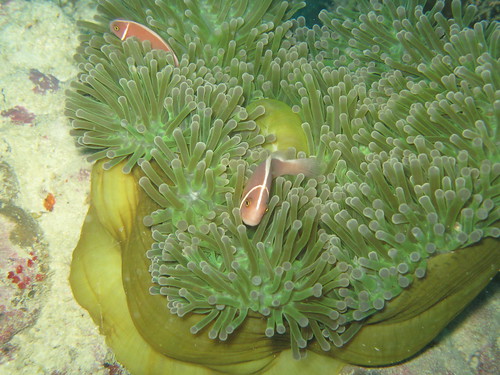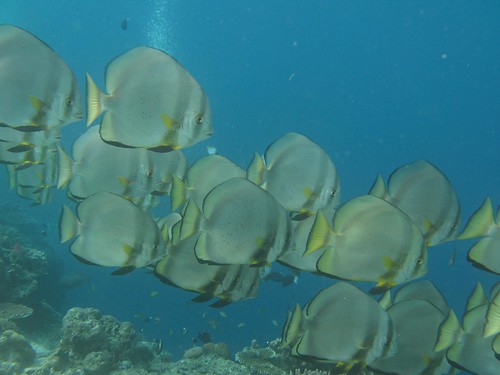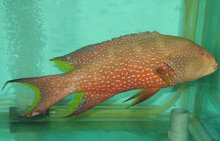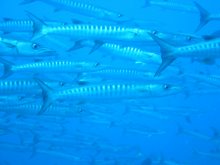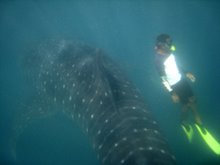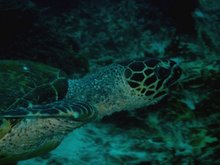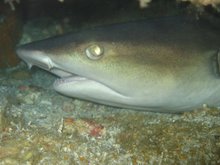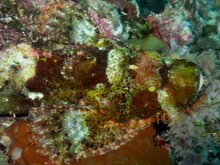Monday 10 December 2007
Cutting total catches increases profitability
The simple reason is that when stocks are plentiful they become easier and cheaper to catch.
This is not rocket science but is a departure from traditional fisheries management, where the maximum highest sustainable catches are set so as to not deplete stocks.
The research shows that there would be higher profits if stocks were kept at a higher level.
"We calculate that we should be conserving about 65% of the virgin biomass whereas at the moment we're down to about 30%."
Source:BBC (Quentin Grafton, Australian National University,Canberra
This is good news for those of us that want to see marine biodiversity maintained.
The full report from the BBC can be found http://news.bbc.co.uk/2/hi/science/nature/7127761.stm
Thanks to Charlie for passing this on
WWF-HK starts a shark fin campaign
- Most shark fisheries are poorly managed and unsustainable.
- Huge wastage, 90-95% of the shark is disposed of after the fins are cut off.
- 20% of the 546 shark species on the IUCN redlist are threatened with extinction.
Consumers should stop eating shark fin and restaurants should stop selling it.
The full story can be found Click HERE
Thursday 6 December 2007
Fish don't have many friends
Hong Kong marine species struggling to survive
Also worth noting is :
"the dire situation facing the globally Critically Endangered Chinese Bahaba and locally depleted Hong Kong Grouper, both well-known edible fish in Hong Kong, were largely unknown to the general public. Mr Alex Fong, Ocean's 10 Ambassador of WWF Hong Kong said, "The polling results show charismatic marine species such as the Chinese white dolphin and Green turtle have received far greater public attention than commercially important fishes"
Sounds like a familiar story. There is a need to focus on better protection not only on individual species but the setup and real complete protection of a variety of marine habitats.
The story from WWF can be found here: http://www.wwf.org.hk/eng/pressreleases/20071115.php?source=eNews200711_1
Tuesday 27 November 2007
Whaling starts again in earnest
"The fleet intends to kill more than 1,000 whales while in the Southern Ocean, including 50 endangered fin whales, 50 threatened humpback whales and 935 minke whales. " Source : Greenpeace
The slaughter of endangered fin and humpback whales is inexcusable. These species are IUCN listed, respectively as
- Endangered ("A taxon is Endangered when it is considered to be facing a very high risk of extinction in the wild" source: iucn.com) and
- Vunerable ("A taxon is Vulnerable when it is considered to be facing a high risk of extinction in the wild")
- It would be better in many ways if we did not interfere with the natural world at all, however excluding human extinction this is not realistic or achievable and thus I have no real problem in sustainable fishing of a species, the current levels of hunting minke whales is sustainable
- From a conservation perspective, the West's argument about species killing needs to be consistent, not just focused on high profile intelligent or cuddly animals
- all species in the world have a right to live whether they are minke whales, napoleon wrasse, corals or ameoba
- Inconsistent treatment confuses the conservation and species protection message, we should be focused on ensuring ecological balance, let the natural balance of life work its wonder.
Arguments?
Wednesday 21 November 2007
Fish dumping will ruin industry (sic)
The report(s) can be found here:
http://news.bbc.co.uk/2/hi/uk_news/7103363.stm
http://news.bbc.co.uk/2/hi/uk_news/7102241.stm
The destruction and wastage is terrible and very very sad of course, but my believe is that the fishing industry is wholly responsible.
Here is my suggestions.
- European wide fishing quotas must remain and need to be strictly enforced based on scientific evidence.
- Fazing out of trawling within areas of high biodiversity, and introduction of penalities for their use.
- Investment into sustainable shrimp fishing and shrimp farming.
- Consumer education and labelling into the shrimp industry and the source for shrimps on supermarket shelfs.
The above should also be introduced into the Asia Pacific region as an urgent matter
Saturday 10 November 2007
Fishing ban called for Bluefin tuna
This is a follow up to an earlier blog on Bluefin Tuna, click here
Miracle if anything positive comes out of this ICCAT meeting, as there is a history of indecision.
This latest story can be found here:
http://www.panda.org/index.cfm?uNewsID=116941
Thursday 8 November 2007
South East Asia's Oceans running out of fish
A new report from Australia's Lowy Institute spells out what we have all know for a long time, overfishing in South East Asia is depleting SE Asia's fish stocks and coral reefs. Source:Environmental News Network http://www.enn.com/top_stories/article/24297
Few quick points
- Fisheries in the region have expanded dramatically in the past few decades
- Thailand, Vietnam, Indonesia and Philippines are now inthe top 12 fish producing countries in the world.
- In the Gulf of Thailand, the density of fish had declined by 86 percent from 1961 to 1991, while between 1966 and 1994 the catch per hour in the Gulf by trawlers fell more than sevenfold.
- In the Gulf of Tonkin, where Vietnam shares resources with China, the record was even worse with fish catch per hour in 1997 only a quarter of that in 1985.
- In the Philippines, most marine fisheries were overexploited by the 1980s, with catch rates as low as 10 percent of rates when these areas were lightly fished.
- As the fourth largest country in world fish production, Indonesia is a fisheries giant. Yet ... Indonesian marine fisheries resources are close to fully exploited and a significant number in all areas are over-exploited.
Recommendations in the report include
- Help Southeast Asian countries build their capacity for fisheries management.
- The principle of stakeholder inclusion in its fisheries interventions by stressing the importance of including views from fishers’ representatives, environmental organisations, community and women’s interests, consumers and the private sector representing the retail, food service and fish processing sectors.
- Substantial increase in the amount of marine conservation research.
- Regional bodies such as APFIC, ASEAN and SEAFDEC need to create a regional process to assess fisheries resources and to provide advice to fisheries managers in a form suitable for local use.
- Consumer information, correct labelling of country and source of origin, in an effort to increase awareness of and pressure for sustainable fish products as well as combat illegal fishing.
Full report can be found on the Lowy Institute website as follows:
http://www.lowyinstitute.org/PublicationGet.asp?i=714
Monday 29 October 2007
New nudibranch discovered in Hong Kong
Click on the following link.
http://www.hkoutdoors.com/forums/activities/undescribed-nudibranch.html#962
There are hidden gems in the waters of Hong Kong. More work needs to be done to preserve it before it is too late.
Tuesday 23 October 2007
Hoi Ha Wan - A marine park in Hong Kong
Under Hong Kong legislation marine parks are protected to some degree,the following picture, taken in Hoi Ha, indicates the activities not allowed :

The key points are that fishing is still permitted in the Marine Parks, to licensed fishermen and that the park is not adequately policed. On a visit during the weekend of the 20th October 2007, I found the following character right on the beach under Hoi Ha Wan village and a stones throw from the AFCD office.

Unfortunately at the time I took this photo I could not tell that he had a seastar in his hand, otherwise I might have spoken to him, as he walked away I could see that he had a nine inch long divers knife, strapped to his leg. One can only guess what he was looking for, however what ever is it he should not be doing it..
There is a growing disquiet in Hong Kong about inadequate protection of marine life AND about the lack of knowledge about the issues. All things marine are seen as inexhaustible.
Wednesday 10 October 2007
Apo reef - fishing banned
Apo Reef (note: not the similarly named Apo Island, a marine reserve off Negros Island in the Southern Philippines) located off the west coast of Mindoro in the Philippines is trying to relive "old glories" and has put into place a total ban from 2nd October on "all extractive activities such as fishing, collection and harvesting of any life form"
Full article, courtesy of WWF-Philippines can be found HERE
One of the key problems with setting up these kinds of No-Take reserves is resistance from the local fishing community, to overcome this alternative sources for fishing have been developed, through installation of overshore fish aggregation devices. A local solution to the local situation, resistance will persist, but hopefully with increased fish aggregations and increased tourism, the project will be successful.
A worthwhile project to support and I hope to visit sometime soon.
Monday 8 October 2007
The Harm of Good Intentions - turtles
The argument of this article posted on the WWF Philippines blog puts forward a compelling argument as to why turtle hatchlings should be left and not collected, fattened up and then release later. Essentially the argument is as follows:
- Within the first 24 hours of life turtle instinct is to go out beyond the surf zone to catch major currents. They are carried to development areas where they remain until strong enough to migrate distances, it is during this period that the turtles learn about the currents and their migration routes. Key to their survival.
- The turtles reproduction process has proven very successful, without human intervention and has enabled the turtles to out live the dinosaurs.
Obviously turtles need a helping hand when human interference is affecting the survival, such as egg collection or fishing by catch but other than that, maybe we should leave them alone...?
Are they right..?
Full article can be found here:
http://newsfromkkp.blogspirit.com/archive/2006/03/21/the-harm-of-good-intentions.html
Sunday 23 September 2007
Shrimp/prawn farming - the bad news in detail
The following two links provide some more information and are interesting reading.
Hungry for change: EJ Foundation campaign for ethical shrimp (read prawn) farming and fisheries: click here
Details report into the shrimp industry : click here
The conclusion of the executive summary section of the "...costing the earth" report says:
"Immediate action is necessary by all stakeholders and specifically governments, the shrimp farming industry, seafood producers, traders and retailers plus aid and development agencies, which together are promoting or indirectly supporting the unsustainable and unethical practices of this industry."
The consumer guide references a need to be aware of what you are eating, ask the right questions of the restaurants and supermarkets and only buy ethically produced prawns.
Now that is the challenge. I don't see any labels or information to help consumers in this regard, maybe if we started to ask then this will start to happen.
Thursday 20 September 2007
EU closed Bluefin tuna fisheries for the rest of 2007
There are three bluefin tuna species, all provide the highly prized flesh for sushi and shashimi in Japanese restaurants worlwide. All species are critically endangered due to overfishing.
Northern bluefin tuna (Thunnus thynnus)
Southern bluefin tuna (Thunnus maccoyii)
Pacific bluefin tuna (Thunnus orientalis)
We should all reduce consumption of this fish. See the seafood guides for more information:
Click here for the seafood guides
Press release for the closure of the fisheries for 2007 :
http://ec.europa.eu/fisheries/press_corner/press_releases/com07_60_en.htm
Press release regarding sustainable fisheries for the bluefin tuna
http://ec.europa.eu/fisheries/press_corner/press_releases/archives/com06/com06_88_en.htm
Monday 17 September 2007
Malaysian ministry bans shark's fin soup
"Ministry bans shark's fin soup - Malaysiakini.com ( http://malaysiakini.com/ ) Sep 15, 07 4:16am
Malaysia's Natural Resources and Environment Ministry has struck off shark's fin soup from the menus at official functions, to help conserve the species, a report said today.
Minister Azmi Khalid told the official Bernama news agency that the ministry had made the commitment to the Malaysian Nature Society.
"By refraining from the consumption of shark's fin soup, it is hoped that the ministry would contribute in one way or another towards the current conservation efforts for sharks species," he said.
"Their demise would start off a domino effect, which at each stage could result in the depletion or overpopulation of other fish and marine species leading to an imbalance in the marine ecosystem," he said.
On preservation drive
The society's Selangor branch Marine Group is on a drive to encourage individuals and organisations to stop serving the delicacy at corporate functions.
The marine group had embarked on a series of activities and programmes to promote awareness on the plight of sharks and their importance to the marine ecosystem.
Malaysia's population is dominated by Muslim Malays, but there are also large ethnic Chinese and Indian communities."
What can be done to raise the awareness of this and to try to get other governments and ministries in the region follow suit...?
Monday 10 September 2007
Dead blacktip shark in Hong Kong marine park
Check out the following story:
http://www.news.gov.hk/en/category/environment/070830/html/070830en04003.htm
This has opened up the debate about whether fishermen should be allowed to fish in marine parks. The HK government does allow a limited number of fishing permits to be issued annually.
I don't think any fishing should be allowed in designated marine parks.
Friday 31 August 2007
FAO plan for conservation and management of sharks
Carrying on with the theme of Sharks and Shark fishing, The Food and Agriculture Organisation of the United Nations, ratified an "Action plan for the conservation and Management of Sharks'.
On the website of the FAO the only countries that have put together and published a plan for sustainable shark fisheries are Canada, Japan, Australia, Mexico, Taiwan, United Kingdom, United States, Malaysia, and Ecuador, as well as a Mediterranean wide plan.
However the action plan is voluntary and not legally binding. Bad news is that the Ecuadorian government in early August has lifted the ban on sales of shark fins. This is politically motivated move by the president to court fishermen prior to a up coming election. (source: guardian.co.uk)
The European Union are also guilty of killing huge numbers of sharks and recent attempts to list the Porbeagle and Spiny Dogfish onto CITES was not ratified. These species are consumed in Europe at alarming rates with the fins being sold to China.
All divers appreciate and love to see sharks, and they are a vital part of the marine ecology, isn't it time more was done to protect and enforce international legislation and protection of sharks.
FYI. The FAO website lists the aims of a national shark-plan should be to:
- Ensure that shark catches from directed and non-directed fisheries are sustainable
- Assess threats to shark populations, determine and protect critical habitats and implement harvesting strategies consistent with the principles of biological sustainability and rational long-term economic use
- Identify and provide special attention, in particular to vulnerable or threatened shark stocks
- Improve and develop frameworks for establishing and co-ordinating effective consultation involving all stakeholders in research, management and educational initiatives within and between States
- Minimize unutilized incidental catches of sharks
- Contribute to the protection of biodiversity and ecosystem structure and function
- Minimize waste and discards from shark catches in accordance with article 7.2.2.(g) of the Code of Conduct for Responsible Fisheries (for example, requiring the retention of sharks from which fins are removed)
- Encourage full use of dead sharks
- Facilitate improved species-specific catch and landings data and monitoring of shark catches
- Facilitate the identification and reporting of species-specific biological and trade data
Wednesday 22 August 2007
Sharkwater - the movie
Have a look at the website and trailer by clicking http://www.sharkwater.com/ the film does put across a very important message.
Unfortunately the film is not yet due for release in Asia as the producer :
"We would love to have the film release in China and Hong Kong but unfortunately we have seen some resistance"
I am currently seeing whether there are ways that this can be released in Hong Kong and China but I have limited influence or contacts in the cinema/film distribution industry. Anyone have any ideas?
Sunday 12 August 2007
Intro to marine organisms - 2
1. Octopus (Octopus Sp.)
A member of the mollusc family, the octopus has no skeleton and is a master of disguise. Their amazing ability to change colours and skin texture enables them to almost literally disappear into the background. You only really see them if they happen to move or if you are particularly eagle eyed.

(her?) annoyance before squeezing into a tiny crevice
Octopus are clearly highly intelligent and in experiments have been shown to have maze and problem solving abilities. Octopus are not currently endangered however they are popular food animals.
2. Emperor Angelfish (Pomacanthus imperator)
A spectacularly beautiful fish that reaches upto 40cm in length however they are more typically upto 30cm in length. The picture below is a mature animal, juveniles have a completely different coloration and pattern, with concentric blue and white circular lines on a dark blue background.
 Emperor angel fish been cleaned by resident 'cleaner wrasse'.
Emperor angel fish been cleaned by resident 'cleaner wrasse'.Most angelfish are seen in pairs that are highly territorial, never locally common, angelfish are sometimes captured for the aquarium trade, a practice that should be discouraged given the difficulty and territorial nature of the animal.
3. Sponges
Sponges are extremely common and are thus a highly successful animal, earliest fossil records have sponges as much as 1000 million years old. They take many forms for instance a red encrusting sponge is shown in the emperor angelfish picture above through to the largest species, the barrel sponge. Sponges are the most primitive of multicelled animals and are pretty much a colony of individual cells, they have no muscles, nerves, true tissues or internal organs.

Sponges are filter feeders and form an important part of the reef ecology, acting as 'hosts' to a menagerie of smaller organisms. Some species are commercially important, harvested to keep us clean as we take showers.
4. Snapper
This is a diverse fish family that are both important predators on reefs as well as important commercially caught food fish. There are more than 100 species worldwide, most of these are found around the western pacific region. Many species form large schools, the species below typically is solitary waiting over reef shallows waiting for suitable food to come swimming by.

One spot snapper (Lutjanus monostigma) in a typical reef scene in
relatively shallow water (12m). A swarm of reef fish that also includes
goat fish, damsel and parrotfish. Photo from Puerto Galera, Philippines
5. Maxima clam (Tridacna maxima)
Related to the giant clam, the maxima clam is a brightly coloured mollusc that is closely related to the giant clams (which is now a increasingly rare animal) They attach themselves to the reef and grow slowly, competing with corals and other invertebrates for space and access to sunshine.
 Maxima and giant clams have a close and dependent relationship with algae (zooxanthellae) that gives the animal it's vibrant colours. Due to this dependence Maxima clams are found in the shallow areas of reefs, where there is a lot of sunlight.
Maxima and giant clams have a close and dependent relationship with algae (zooxanthellae) that gives the animal it's vibrant colours. Due to this dependence Maxima clams are found in the shallow areas of reefs, where there is a lot of sunlight.
Thursday 9 August 2007
Seafood guides - global selection
The following are some of the ones available, choose which is more appropriate:
Hong Kong/South East Asian
http://www.wwf.org.hk/images/conservation/seafood/HK-card-fold.pdf
European/British in focus
http://www.fishonline.org/information/MCSPocket_Good_Fish_Guide.pdf
American
http://www.mbayaq.org/cr/SeafoodWatch/web/sfw_regional.aspx
Canadian
http://www.seachoice.org/files/asset/file/37/SeaChoice_Alertcard.pdf
Thursday 2 August 2007
Hong Kong: juvenile green turtles released
Mid July 2007 a total of 61 green turtles (Chelonia mydas) were released at Tai Long Wan in Hong Kong's North Eastern, Sai Kung country park.

Heading out to open sea, photo from http://www.news.gov.hk
The juveniles were under the care of AFCD and Ocean Park staff since their mother laid eggs on Tai Long Wan last September and have grown from 25g to 800g in weight and 5cm to 16cm in shell length. This will give the youngsters a fighting chance of surviving and returning to Tai Long Wan.
All of the youngsters were micro chipped for future identification.
Story on the HK government website can be found Click HERE
The green sea turtle is an endangered species, under threat from habitat loss, pollution, fishing by catch and hunting/over exploitation.
Sunday 29 July 2007
Dolphinariums and dolphin drives


Risso's Dolphin at the Taiji Whale Museum
There is an educational aspect to the "museum" in that tourists are able to see and have a positive experience with these various cetaceans. However at what cost... there is a darker side to Taiji and it's Whale Museum.
Many people will be familiar with or heard about Dolphin drives in Japan and the brutal nature of the slaughter (check out the following website Click HERE) Actually the Taiji Whale Museum has been implicated in these hunts. A certain percentage from the hunts are taken aside by the Taiji Whale museum to provide for the dolphin petting experience or to provide live cetaceans to Oceanariums worldwide.
Ocean Park, Hong Kong has done some studies into Mainland Chinese oceanariums/dolphinariums and where they source their dolphins and I have sent an enquiry to them for some information.
Taiji Whale Museum and any oceanarium that sources from this brutal slaughter are to be avoided at all costs.
Of course this brings the bigger question of whether we should have dolphins and other cetaceans in captivity at all.
Thursday 5 July 2007
Alaskan fisheries authority react quickly and close down commercial fishing
Interesting article passed to me by Alison Bradley (thanks Alison) points to a link between climate change and the stalled recovery of the 'overfished' cod fisheries in the North West Atlantic.
This link in a report by the University of Massachusetts, has led to the North Pacific Fishery Management Council making history by "summarily prohibited any bottom-trawl commercial fishing off the far north of Alaska past the Bering Strait — at least until scientists figure out the effects of sea ice retreat and warming."
The full story can be found HERE
The fast action of the Alaskan fisheries authorities should be applauded, fast and decisive action from scientific evidence is needed in many others areas, here's a few that immediately come to mind:
- European fisheries in the North Sea and the Atlantic, near collapse.
- WWF-HK's call for no catch zones in Hong Kong waters. Setting up of marine parks has seen little recovery
- Bluefin tuna worldwide, a species now critically endangered.
- The live fish trade in South East Asia, both due to unhealthy fishing practices and overfishing.
- Shark finning, absolutely unsustainable.
Wednesday 4 July 2007
Sea Turtle Conservation and Tourism Clash on Japan's Yakushima Island
http://www.enn.com/net.html?id=2025
Essentially this article talks about how growing ecotourism on the island of Yakushima, Japan, is damaging the nests of the endangered North Pacific Loggerhead turtle.
To me this shows the increasing interest and thus the increasing value in environmental tourism, but clearly not all Ecotourism is created equal. Care must be taken to research and choose appropriate conservation enhancing Ecotourism destinations that also directly benefit local people. If you don't like what a tour group or "Ecotourist" site is doing, don't participate and publicise, on this BLOG and others, what you don't like.
Thursday 28 June 2007
Intro to marine organisms - 1


3. Mantis shrimp. A crustacean often found scurrying across sandy patches and under rocks and coral outcrops. There are many different subspecies, but typically they have a jack hammer appendage used to smash open the tough shells of their main prey, crabs. Their eyes are mounted on two stalks and are said to be the most complex of any animal (for instance each individual eye is capable of trinocular vision and depth perception). A fascinating creature.

4. Sea apple (Pseudocolochirus violaceus) , the sea apple is a colourful sea cucumber, capable of withdrawing into a ball the photo illustrates the animal extending its tenticles.
5. SeaStar (the correct common name for star fish) there are many different types, many strikingly beautiful and can easily be seen when diving or snorkling. Seastars are members of the Echinodermata family and closely related to sea cucumbers, sea urchins and feather stars.
6. Whip coral. This yellow specimen in the photo has its polyps extended, a number of small reef fish can be seen in the photo as well (anthia, wrasse, chromis).
Corals as a whole are members of the Cnidaria family and are closely related to sea anemones and jellyfish (amongst others) the polyps are individual animals that form large colonies. Many types of corals have built massive structures (e.g. the great barrier reef), these structures form arguably the most diverse ecosystems on the planet and vitally important for the overall health of the oceans. Unfortunately they are highly vunerable and increasing under threat.
Friday 22 June 2007
Sources for environmentally sustainable shrimps/prawn
- US Farmed Shrimp. Some of these farms are located far away from the sea and are re-circulating, closed-water systems that rear the shrimp in tanks.
Caveat : no clear way to know, as far as I can tell, where the shrimps are exactly farmed. As a reminder, typically shrimp farms are located on the coast causing significant environmental impact to susceptable coastal ecosystems. - Organic shrimp. In the absense of formal Shrimp Aquaculture certification, there are a few shrimp farms that are certified organic, these do aim to supply shrimp without the use of chemicals, antibiotics, hormones or preservatives. Some of these farms are located in Florida and Ecuador.
Caveat : Certified Organic doesn't necessarily mean environmentally sustainable. - Spot shrimp. Caught in temperate seas off Alaska using Traps.
Caveat : Signs of overfishing. British Columbia shrimp fishery 'is fully fished, status of other fisheries is unclear' source - Seafood choices alliance
Another finding of note is that attempts in Thailand to place shrimp farms away from susceptable coastal areas suffered a set back with the Thai government banning this practice since 1999. The reason was that the waste from the shrimp farms left potential farm land ruined. Typical shrimp farms typically only work for a few years before the land has to be abandoned. It has been estimated that to return the land back to 'normal' takes 30 years. Source : Wikipedia
All in all not really a pretty picture. I continue to avoid shrimps or prawns.
Wednesday 13 June 2007
Chinese turtle boat with 397 dead sea turtles aboard discovered

Source: http://www.turtle-foundation.org
In China turtles are considered a symbol of longevity and presumably these were destined as cheesy decorative pieces in office receptions and the bosses living room.
The following was the grusome findings from the seizure.
- 296 Hawksbill Turtles, a critically endangered species. Treated with formalin, size of carapace: 20 - 90 cm
- 90 Green Turtles, an endangered species treated with formalin, size of carapace: 20 - 90 cm
- 1 Olive Ridley Turtle, also an endangered species.
- 4 cans of formalin with 25 liters each, 100 Liter in total
- 17 nets with 38 cm nitting distance
- 3 giant mussels, approx. length: 100 cm
- 1 stuffed pufferfish
- 2 speedboats with 60-PS-engines
More information can be found on the Turtle Foundation website. By clicking HERE
Saturday 2 June 2007
Conservation of sea turtles in Hong Kong
Actually a lot is done to protect the beach area during the potential nesting period, teams of volunteers and staff from the AFCD aim to make the beach as hospitable as possible and illegal entry onto the beach is subject to a maximum fine of HK$50,000.
More information can be seen click here
Friday 1 June 2007
Green turtle nesting season is starting in Hong Kong
"The Green turtle nesting season has run from June to October in the past but numbers returning have dropped to perilously low levels in recent years. Ever since 2003, no Green turtles (Chelonia mydas) have nested at the Sham Wan beach on Lamma Island, which is the only site where Green turtles have nested regularly in recent decades. "
Source: WWF Hong Kong e-News 31st May
WWF also requests the following actions to encourage Green turtles to return
- Support WWF's Save our Seas (SOS) campaign to prevent our marine ecosystem, where marine turtles rely on, from collapsing.
- Beach visitors, divers etc should avoid disturbing any marine turtles in the water or at beaches identified for marine turtle nesting, i.e. Sham Wan and Tai Long Wan, as a passive effort to encourage turtles coming back to Hong Kong for nesting.
- Report any sightings to AFCD by calling 1823 during this coming June to October nesting period!
Thursday 31 May 2007
Sustainable fisheries or aquaculture (seafood farming)
Sustainable fisheries.
The Marine Stewardship Council, undertakes a detailed certification process for world fisheries. WWF Hong Kong is heavily relying on MSC certification for their Seafood Guide (click HERE for previous BLOG on this topic)
The process of certification can take upto 2 years to complete (as can be seen from the certification application of the "Hastings Fleet Pelagic Fishery", this assessment lasted from October '03 to September '05)
The list of MSC certified fisheries can be found click HERE
The list contains many North American, European and Australian fisheries and contain a variety of seafood species, however no Asian fisheries or shrimp/prawn fisheries have been certified.
Sustainable Fish Farming
There is an Asia Pacific Organisation "Network of Aquaculture Centres" " is an intergovernmental organization that promotes rural development through sustainable aquaculture", click HERE for their website.
NACA in collaboration with the Food and Agriculture Organisation of the United Nations (FAO) has initiated a certification process for sustainable Aquaculture click HERE for notes about this certification. As far as I can tell no certificates have been issued and as can be seen from the information on the NACA website their major focus is on farming and rural community development. This certiffication process is only playing lip service to the issue.
Further potential confusion is the Thai Quality Shrimp certification (click HERE) Their Good Aquaculture Practice guidelines, even though they state, should not generate any environmental impacts are focused on producing a consumer safe product.
Groups such as NACA and Thai Quality Shrimp have no real interest in environmentally sustainable seafood farming and as such these efforts should be ignored from this perspective.
The Hong Kong Agriculture,Fisheries and Conservation Dept (AFCD) has an "Accredited fish farm scheme", this again is focused mainly on production of a safe product for the end consumer.
The is obviously space for certification and following through with identification of sustainable seafood farms, however this is not yet obvious.
No real conclusions yet, my investigations will continue.
Thursday 24 May 2007
Indonesia protects 900,000 hectares through network of Marine Protected Areas
Through the setting up of seven separate Marine Protected Areas (MPA's). A vast 900,000 hectares of tropical water are newly protected in the Indonesian archipelago of Raja Ampat. Raja Ampat is in the far east of Indonesia, bordering the Island of West Papua and is well know as Marine Biodiversity Hotspot. Click HERE for an overall map of the area.
This announcement by the Indonesian Minister of Marine Affairs and Fisheries Mr. Freddy Numberi, was as a result of efforts and campaigning of the local Fishing Communities and NGO's organisations such as Conservation International.
What has been happening in the recent past is that because of encroachment by non local commercial fishing boats in the area the local fishing communities have been suffering increasingly from reduced catches, threatening local livelihoods. Local communities will be jointly managing the MPA's.
The area can be visited and there are a number of liveaboard operators in the area (For example, MV Bidadari, who I dived with recently in Komodo, has a sister ship Sevens Seas, that operates in the area)
Full report from Conservation International, can be found Click HERE
Monday 21 May 2007
Countries with the largest coral reef systems

Source : UNEP, orginal can be found here HERE
A little surprised that the Maldives was quite so low, given the size of the atolls. Other countries of note:
Sudan, ranked 24, total area 2,720
Thailand ranked 26, total area 2,130
Mozambique, ranked 28, total area 1,860
Belize , ranked 33, total area 1,330
Palau, ranked 39, total area 1,150
Wednesday 16 May 2007
Napoleon wrasse on menu - AFCD response
"Thank you for your information and enquiry regarding possession of humphead wrasse (Cheilinus undulatus) for commercial purposes.
Please be advised that humphead wrasse was newly controlled in Hong Kong under the Protection of Endangered Species of Animals and Plants Ordinance since 1 December 2006. For those newly listed species, the Ordinance permits a 6-month grace period during which a restaurant may apply for a possession licence for those humphead wrasse acquired before the Ordinance came into effect. The grace period will expire on 31 May 2007. By then, a restaurant should have a valid licence to possess humphead wrasse for commercial purposes.
According to our record, an application for a possession licence is not yet received from the concerned restaurant. Nevertheless, we have taken note of the situation and will keep this in view for any necessary action. "
Very informative response....!
Tuesday 15 May 2007
Napoleon wrasse on menu in HK restaurant
 Juvenile (35cm) Humphead/Maori/Napoleon wrasse (take your pick)
Juvenile (35cm) Humphead/Maori/Napoleon wrasse (take your pick) The restaurant was the Victoria Seafood restaurant, 5th floor, CITIC centre, Central, Hong Kong.
I have sent an email to both the AFCD (Agriculture, Fisheries and Conservation Department), HKU and the WWF to seek clarity on whether the restaurant has the required CITES import permits.
This is a beautiful fish that does need protection to ensure its survival.
A useful website on the status of the Napoleon wrasse can be found HERE
Friday 11 May 2007
Saving the Sea's Bounty - National Geographic
- The Global Fish Crisis: high tech fishing is 'gutting' the world oceans. Many species have declined by 90%. Have a look at one sample photo ("shrimp bycatch cascade of death"), that illustrates the tremendous waste.
 Another key point in this article is the horrendous fishing and fattening process that feeds the growing insatiable appetite for tuna, the much prized Bluefin Tuna, is now critically endangered. Be very careful what you eat.
Another key point in this article is the horrendous fishing and fattening process that feeds the growing insatiable appetite for tuna, the much prized Bluefin Tuna, is now critically endangered. Be very careful what you eat. - Blue Haven. In New Zealand a number of no take marine reserves are having amazing results and increasing the fish catch (by overspill from the reserves) Started by Bill Ballantine, local fishing communities are now avidly supporting this idea. Why can't it be done in other areas, as avocated by WWF-HK.????
- End of the Line. A well know story of the complete collapse of the Newfoundland Cod Fisheries. A clear example of the real human effects of unsustainable fishing.
This edition of the National Geographic is a good read.
Monday 7 May 2007
Additional Seafood guide - have a look
As the slogan goes:
If the buying stops the killing can too..
I have found another very informative seafood guide, which can help us to be better informed and to become advocates for sustainable seafood. This can be accessed here
This is from the Monterey Bay Aquarium, it is a little US centric but I like it... why?
- Lots of information about what you should eat and what you should avoid.
- Easy to search and browse for a particular species.
- You can see what the fish/shell fish looks like. Very helpful.
- I think there are some additional ideas here that WWF can use to spice up their Seafood guide and campaign. I will send this onto them.
Click on the "WHAT YOU CAN DO" link. I have gone further and made a pledge to become a Seafood Watch Advocate. Watch out...!!
Thursday 3 May 2007
Status of South East Asian Coral Reefs
The longer the blue lines, the better and the shorter the brown line the better. I am not exactly sure of the methodology taken on this survey but my take on what this is showing is that between 1994 and 2004:
- Indonesia has shown an improvement, critically the only country to show a decrease in the amount of coral reefs with less that 25% live coral cover (LCC)
- Malaysia has also shown an improvement, but only in the >75% LCC category.
- Vietnam has the biggest decline in LCC. Their reefs look in critical trouble.
- Myanmar's reefs look the healthiest. But no indicator of the status in 1994. Also should be noted that Myanmar has no GCRMN co-ordinator.
- Philippines has also seen a significant decline in this ten year period, especially with regards to the less than 25% LCC category.
The biggest risks to the reefs were listed as overfishing and destructive fishing.
This survey does not indicate the total area of reef coverage in those perspective countries.
More on this topic later.
Tuesday 1 May 2007
Napoleon wrasse taken off the menu in Manila
Press release can be found here here
So public campaigns can make a difference and make changes (not that I had anything to do with this particular case)
South China Sea: Scarborough Reef used as target practice.!
Scarborough Reef, located 200kms to the west of Subic Bay is an area of great biodiversity:
"The U.S. military used the reef for bombing practice during the 1990 confrontation with Iraq, complicating matters. Large and unique underwater dunelike structures of organ-pipe coral tens of meters long were used as targets. Substantial areas of coral were torn apart by the explosions." Source : World Resources Institute
Short but complete article on Reefs at Risk - Scarborough Reef can be found here
Monday 30 April 2007
Closure of coral beach in Hoi Ha Wan Marine Park
"prohibiting the entry of all persons and vessels into the Area are for the protection of corals by reducing human activities and impact in the Area"
Seems a step in the right direction, however it is still possible to fish in other parts of the park with the correct permit.
Still some way to go..
Notice can be found here
Sunday 29 April 2007
Whale shark rescues in India
http://www.wildlifetrustofindia.org/html/news/2007/070416_whale_shark_rescue.html
Indian fishermen are compensated Rps25,000 for saving whalesharks caught in their nets. This appears to contrast to what is happening in other areas.
" use of the Whale Shark for food is mainly for its meat and has been documented in Taiwan, India, and the Philippines. Work carried out by TRAFFIC in co-operation with researchers at National Taiwan Ocean University in 1996-1997 identified Taiwan as a major, and possibly the largest, market for Whale Shark meat. " source: traffic.org
It should be noted that Taiwan is introducing innovative ways to ensure sustainable trade in Whaleshark meat.
Saturday 28 April 2007
Komodo National Park - mooring buoy project
The Indonesian and Philippines archipelagos are the epicentre of the worlds marine biodiversity (exact location subject to some debate, try to google 'marine biodiversity epicentre' for some intriguing differences of opinions) Komodo is certainly a magical place, great diving, huge variety of things to see underwater and fantastic scenery above sea level. To add to this is the unique terrestrial ecology of Komodo and Rinca islands.
With the recent increase in dive boats operating in the Park, an extensive mooring buoy project was initiated by Helen Newman. This project had the active involvement of the diving community in Komodo and was completed in February 2007. Coincidently this was when I was diving in the Park on the live aboard dive boat, MV Bidadari. We were the first boat to utilise a few of the new buoys.

Ouch, the potential damage to reefs is
obvious
This is the kind of project that will make a real difference and is one piece that will help to ensure the survival of this unique marine reserve. Other challenges still exist, but that is another story.....
The full final report on the mooring buoy project can be read by clicking here
Are there any other worthwhile projects out there that should be mentioned?
Friday 27 April 2007
Whale sharks
A great friend of mine, Peter Emmett, just had a wonderful trip to Donsol in the Philippines, where he snorkled with a number of sharks. Donsol does apparently have the highest density of whale sharks anywhere in the world. (source:Wikipedia) So head down there. Bringing in hard needed revenue to the local fishermen (who traditionally hunt whale sharks) is a great way to ensure its survival.
Thanks also to Peter for pointing out to me whaleshark.org, a not-for-profit organisation working to protect the threatened whale shark. One thing they are aiming to do is to have a photo library of whale shark encounters, to aid in further research. So...
If you do see a whale shark and happen to have a camera in hand, please take a photo (importantly of the pectoral fins and the pattern of spots above and around them) and send to http://www.whaleshark.org/
(more info on what they want, can be found on the above website)
Thursday 26 April 2007
Tiger Shark Feeding video clip - Scary....!!
Clip from "You Tube" showing a shark feed dive in Fiji. Hand feeding a large (3.5 - 4 metre) and very fat Tiger Shark seems absolutely crazy to me. Also check out the worlds fattest Grey Reef's and a one 'normal' non obese Silver Tip. Fish soup as well..
Tiger Shark and more - You Tube clip
Question is: "is shark feeding a good idea"
I think there are two opposing arguments regarding Shark Feed Diving
- Shark Feeds increase encounters with Sharks and can aid in their preservation, by raising awareness and reducing the mystery around sharks.
- In other parts of the world shark feeding has been blamed for the rise in attacks in South Africa. They can become habituated to humans and associate them with food.
I think controlled and well managed shark feeding probably has more plus points that negative.
But for myself, I prefer to see natural behaviour and those unexpected encounters and will vere away from shark feed dives.
Wednesday 25 April 2007
Ciguatera poisoning on the increase
Experts estimate that up to 50,000 people worldwide suffer ciguatera poisoning each year.
Hong Kong has refused to enact mandatory measures to prevent ciguatera despite increased outbreaks. It argues that educating consumers and traders is the answer, rejecting calls to crack down on traders or ban fish from suspect areas.
"Given the fact we eat so much seafood in Hong Kong, this should be one of the priorities in protecting the population," Sadovy said.
Source : wilmingtonstar.com
350 Napoleon Wrasse released back into Marine Park
Eventually the Wrasse were kept alive (with only one dying) near Puerto Princessa, Palawan and released back into the Tubbataha Reef Marine Park (a UNESCO World Heritage Site) at the end of March.
This has caused a stir in the diplomatic channels with the Chinese authorities apparently refusing to admit that this was not only an infringment of territorial waters but a clear endangered wildlife issue. The Chinese CITES authority are refusing to admit the seriousness of the chinese fishing vessels illegal activity.
Google "Hoi Wan" if you want to read more
Tuesday 24 April 2007
Email feedback to WWF on their Seafood guide
With regards to the WWF Seafood guide. On the 10th April, I wrote an email to WWF (seafood@wwf.com.hk) with some initial comments on the Seafood Guide (click here to access guide )
The contents of the email was as follows:
"
- I like the guide, I think that this is a key step in the right direction. Consumer education is absolutely key and this is a good start.
- The common names are none standard. I am not familiar with the English names used on this guide. A side guide (maybe online) with photo’s would be helpful. I notice the URL Click HERE has many but not all of the fish listed on the Seafood Guide. Could this be gradually expanded to include all the fish on your guide?
- I am concerned about the wild caught Chilean Seabass being on the Recommended list, for two major reasons:
- Chilean Seabass (also known as the Patagonian Toothfish) is fished (in many areas overfished) using long line fishing. This fishing method continues to be indiscriminate and has considerable side catch, this is resulting in a large decimation of albatross and seabird populations in the South Seas.
- How can we know that the Chilean Seabass available in Hong Kong is from the MSC certified fisheries and not from other non sustainable sources..?
- The Wikipedia entry summarises this adequately Click HERE - It is a bit difficult to know where the fish are sourced when you are eating in a restaurant. Could you add some comments how what people can do in these cases. E.g. some questions that they could ask. If the right questions are asked then maybe restaurants would also start to source from sustainable sources.
- Are there any recommended sources for Shrimps/prawns. This is extremely popular in Hong Kong and a suitable alternative is needed. At the moment this is only in the AVOID category.
- Chinese Oysters are included, however I think that Globally sourced Oysters are also very popular in Hong Kong. Is there any plans to expand the guide to include these as well as other popular seafood ?
- For non Chinese I think a phonetic representation of the Cantonese pronunciation would be very helpful.
"
As of 24th April, I have not yet received a response.
WWF - Hong Kong
Two campaigns or releases of note:
Seafood Guide: Those that know me, understand that I have been concerned for many years about the restaurant trade in Live Seafood. This guide it the first real attempt at spelling out what Seafood is okay to eat (from a conservation/sustainability point of view) and what Seafood should be avoided. Have a look, there are definitely a few surprises:
Click HERE
Save our Seas ("SOS") We have all been out on Junk Trips and boat trips in Hong Kong and have been amazed at the number and location of fishing boats trawling in Hong Kong waters. WWF's Save our Seas campaign, aims to pressure the government to setup exclusive 'no take' zones that have proved so successful in other parts of the world. Read more here:
Click HERE
About Dod
This is my first attempt at creating a BLOG, it seemed an appropriate moment to try to jot down and share with all my passion for diving and especially for Marine and Coral Reef conservation





